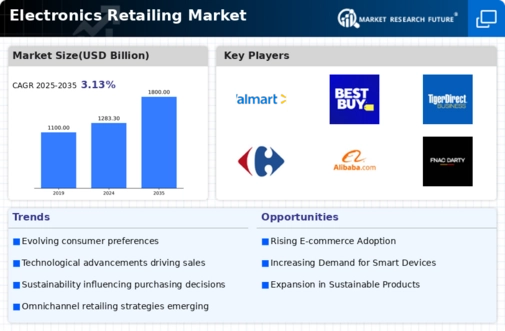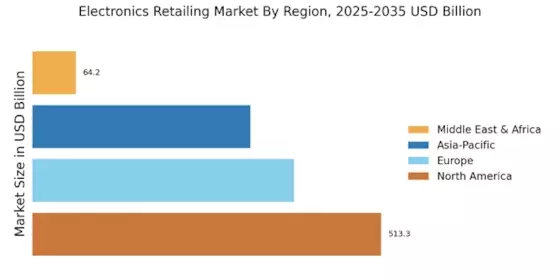E-commerce Growth
The rapid growth of e-commerce is a pivotal driver in the Electronics Retailing Market. As consumers increasingly prefer online shopping for its convenience, retailers are compelled to enhance their digital platforms. Recent statistics indicate that e-commerce sales in the electronics sector have seen a year-on-year increase of approximately 20%, reflecting a shift in consumer purchasing patterns. This trend is further fueled by the proliferation of mobile devices, enabling consumers to shop anytime and anywhere. Retailers are investing in robust online infrastructures and digital marketing strategies to capture this expanding market segment. The rise of e-commerce not only broadens the reach of retailers but also intensifies competition, compelling them to innovate continuously to meet evolving consumer expectations in the Electronics Retailing Market.
Sustainability Initiatives
Sustainability initiatives are becoming increasingly important within the Electronics Retailing Market. As consumers grow more environmentally conscious, retailers are adopting sustainable practices to align with these values. This includes offering eco-friendly products, reducing packaging waste, and implementing recycling programs for electronic devices. Recent surveys indicate that nearly 70% of consumers are willing to pay a premium for sustainable products, suggesting a strong market potential for retailers who prioritize sustainability. By integrating these initiatives into their business models, retailers not only enhance their brand image but also attract a growing segment of environmentally aware consumers. This shift towards sustainability is likely to shape the future landscape of the Electronics Retailing Market.
Technological Advancements
The Electronics Retailing Market is currently experiencing a surge in technological advancements that are reshaping consumer shopping behaviors. Innovations such as augmented reality (AR) and virtual reality (VR) are enhancing the shopping experience, allowing customers to visualize products in their own environments before making a purchase. Furthermore, the integration of artificial intelligence (AI) in retail operations is streamlining inventory management and personalizing customer interactions. According to recent data, the adoption of AI in retail is projected to grow at a compound annual growth rate of 34% over the next five years. This technological evolution not only improves operational efficiency but also fosters a more engaging shopping experience, which is crucial for attracting and retaining customers in the competitive Electronics Retailing Market.
Enhanced Customer Experience
The focus on enhanced customer experience is a critical driver in the Electronics Retailing Market. Retailers are increasingly recognizing that providing exceptional service can differentiate them in a crowded marketplace. This includes personalized shopping experiences, efficient customer service, and seamless return policies. Data suggests that businesses that prioritize customer experience can see revenue increases of up to 10-15%. Retailers are leveraging data analytics to understand consumer preferences better and tailor their offerings accordingly. Additionally, the integration of omnichannel strategies allows customers to interact with brands across various platforms, further enriching their shopping experience. As competition intensifies, the emphasis on customer experience is likely to remain a key factor in driving success within the Electronics Retailing Market.
Consumer Demand for Smart Devices
The growing consumer demand for smart devices is significantly influencing the Electronics Retailing Market. As technology becomes increasingly integrated into daily life, products such as smart speakers, wearables, and home automation systems are gaining traction among consumers. Industry expert's indicates that the smart home device market alone is expected to reach a valuation of over 150 billion by 2026, highlighting the robust appetite for these products. Retailers are responding by expanding their offerings to include a wider range of smart devices, often bundling them with complementary products to enhance sales. This trend not only drives revenue growth but also encourages retailers to develop specialized marketing strategies that cater to tech-savvy consumers in the Electronics Retailing Market.


















Leave a Comment